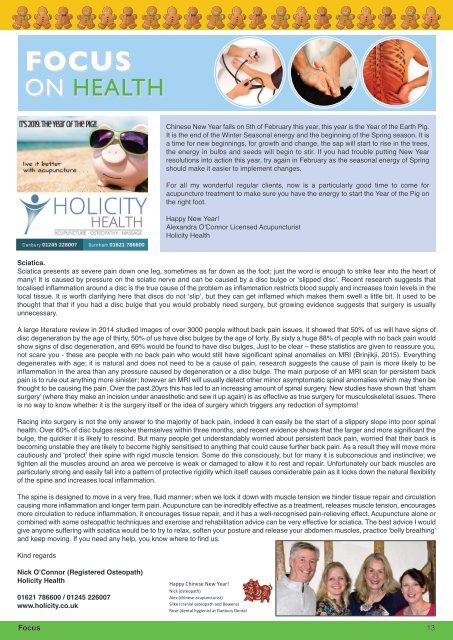Danbury Ing FEB 2019
Create successful ePaper yourself
Turn your PDF publications into a flip-book with our unique Google optimized e-Paper software.
<strong>Danbury</strong> <strong>FEB</strong> <strong>2019</strong>.qxp_Layout 1 29/01/<strong>2019</strong> 13:47 Page 13<br />
FOCUS<br />
ON HEALTH<br />
Chinese New Year falls on 5th of February this year, this year is the Year of the Earth Pig.<br />
It is the end of the Winter Seasonal energy and the beginning of the Spring season. It is<br />
a time for new beginnings, for growth and change, the sap will start to rise in the trees,<br />
the energy in bulbs and seeds will begin to stir. If you had trouble putting New Year<br />
resolutions into action this year, try again in February as the seasonal energy of Spring<br />
should make it easier to implement changes.<br />
For all my wonderful regular clients, now is a particularly good time to come for<br />
acupuncture treatment to make sure you have the energy to start the Year of the Pig on<br />
the right foot.<br />
Happy New Year!<br />
Alexandra O’Connor Licensed Acupuncturist<br />
Holicity Health<br />
Sciatica.<br />
Sciatica presents as severe pain down one leg, sometimes as far down as the foot; just the word is enough to strike fear into the heart of<br />
many! It is caused by pressure on the sciatic nerve and can be caused by a disc bulge or ‘slipped disc’. Recent research suggests that<br />
localised inflammation around a disc is the true cause of the problem as inflammation restricts blood supply and increases toxin levels in the<br />
local tissue. It is worth clarifying here that discs do not ‘slip’, but they can get inflamed which makes them swell a little bit. It used to be<br />
thought that that if you had a disc bulge that you would probably need surgery, but growing evidence suggests that surgery is usually<br />
unnecessary.<br />
A large literature review in 2014 studied images of over 3000 people without back pain issues, it showed that 50% of us will have signs of<br />
disc degeneration by the age of thirty, 50% of us have disc bulges by the age of forty. By sixty a huge 88% of people with no back pain would<br />
show signs of disc degeneration, and 69% would be found to have disc bulges. Just to be clear – these statistics are given to reassure you,<br />
not scare you - these are people with no back pain who would still have significant spinal anomalies on MRI (Brinjikji, 2015). Everything<br />
degenerates with age; it is natural and does not need to be a cause of pain, research suggests the cause of pain is more likely to be<br />
inflammation in the area than any pressure caused by degeneration or a disc bulge. The main purpose of an MRI scan for persistent back<br />
pain is to rule out anything more sinister; however an MRI will usually detect other minor asymptomatic spinal anomalies which may then be<br />
thought to be causing the pain. Over the past 20yrs this has led to an increasing amount of spinal surgery. New studies have shown that ‘sham<br />
surgery’ (where they make an incision under anaesthetic and sew it up again) is as effective as true surgery for musculoskeletal issues. There<br />
is no way to know whether it is the surgery itself or the idea of surgery which triggers any reduction of symptoms!<br />
Racing into surgery is not the only answer to the majority of back pain, indeed it can easily be the start of a slippery slope into poor spinal<br />
health. Over 60% of disc bulges resolve themselves within three months, and recent evidence shows that the larger and more significant the<br />
bulge, the quicker it is likely to rescind. But many people get understandably worried about persistent back pain, worried that their back is<br />
becoming unstable they are likely to become highly sensitised to anything that could cause further back pain. As a result they will move more<br />
cautiously and ‘protect’ their spine with rigid muscle tension. Some do this consciously, but for many it is subconscious and instinctive; we<br />
tighten all the muscles around an area we perceive is weak or damaged to allow it to rest and repair. Unfortunately our back muscles are<br />
particularly strong and easily fall into a pattern of protective rigidity which itself causes considerable pain as it locks down the natural flexibility<br />
of the spine and increases local inflammation.<br />
The spine is designed to move in a very free, fluid manner; when we lock it down with muscle tension we hinder tissue repair and circulation<br />
causing more inflammation and longer term pain. Acupuncture can be incredibly effective as a treatment, releases muscle tension, encourages<br />
more circulation to reduce inflammation, it encourages tissue repair, and it has a well-recognised pain-relieving effect. Acupuncture alone or<br />
combined with some osteopathic techniques and exercise and rehabilitation advice can be very effective for sciatica. The best advice I would<br />
give anyone suffering with sciatica would be to try to relax, soften your posture and release your abdomen muscles, practice ‘belly breathing’<br />
and keep moving. If you need any help, you know where to find us.<br />
Kind regards<br />
Nick O’Connor (Registered Osteopath)<br />
Holicity Health<br />
01621 786600 / 01245 226007<br />
www.holicity.co.uk<br />
]%((;!\6$,*+*!X*0!`*%)


















